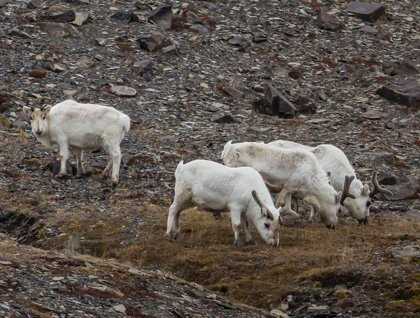Through the night, National Geographic Explorer steamed toward the main islands of Svalbard. While yesterday was our first day in the archipelago, Bjornoya, although officially apart of Svalbard, is quite remote and very different from the islands we explore today. Expedition leader Bud Lehnhausen, chose to kick off the 2014 Arctic season with a landing at Russebuhkta on the southwestern side of Edgoya. This is a beautiful area with amazing diversity.
The Arctic spring and summer seem late in their arrival this season as the snow has only begun its retreat with minimal amounts of tundra uncovered. Hikers fanned out, searching and finding purple sandpipers, snow buntings, red phalaropes, barnacle geese, and even inquisitive Svalbard reindeer that dotted the tundra. The afternoon slipped away in the magic and delight of this snow-covered vista.
The after-dinner plan was for a landing at Kapp Lee, a known walrus haul-out site. As with any landing, the sighting of a polar bear may alter the intention to go ashore. Able-bodied seaman Roel Cagoco sighted the first polar bear of this Arctic season, too close for comfort to our planned landing site. As a result we quickly adjusted from a hike to a Zodiac cruise affording views of both polar bear and walrus. We returned to the ship excited to have witnessed two of the iconic Arctic species on land. But wait, dear reader, there is more.
As the ship continued north around Edgoya, more Svalbard reindeer were sighted grazing in snow-free areas along the slopes. At fifteen minutes to midnight, an arctic fox, still wearing its shimmering winter coat, was sighted scampering along the scree in search of a midnight snack. After an exciting day in the ice, Captain Oliver Kruess was finally relieved on the bridge as the night watch took over the care of our ship. At 12:15 a.m. the first polar bear of the new day was sighted under a towering glacier, but shallow water offshore prevented the ship from approaching close enough to warrant waking up guests. Stay tuned for more exciting encounters as more ice awaits us in Svalbard.









